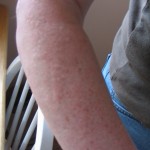
A human arm, four hours after IPL treatment. The raised bumps and red colouration around each hair follicle are typical of this treatment. This normally subsides after three or four days.
Intense Pulsed Light (IPL), as most commonly employed by non-specialist medical practitioners and beauticians, is a method of hair removal from the body involving the use of a specially constructed xenon flash lamp and focusing optics.
IPL technology is also employed in the treatment of medical disorders of the skin including sun damage induced dyspigmentation and vascular changes; poikiloderma of civatte; acne rosacea; broken capillaries/telangiectases; vascular and pigmented birth marks. Such treatment is best administered by a specialist dermatologist, and it should be noted that more advanced ‘second generation’ IPL technology (I2PL) is generally recommended for such disorders. This new technology incorporates ‘dual mode filtering’ and other important advances which result in safer and more effective treatment than the older systems; which were initially designed for simple processes such as hair removal.
Hair removal mechanics: The focused, broad spectrum light is applied to the surface of the skin by way of either a hand-held wand, or by an articulated arm. The intense light travels down the hair shafts, where it strikes the bulb, or root, of the hair. The bulb is usually where the highest concentration of melanin is located, as opposed to the rest of the hair shaft.
When the light strikes the dark-colored melanin, the light is converted to heat energy. The bulb and most of the hair shaft is instantly vaporized. The intense heat radiated by the hair also destroys the hair-producing papilla or the entire hair follicle. It is also claimed that direct light-heat conversion occurs directly in the darker colored capilaries that bring nourishing blood to the follicle.
The pulses of light produced by IPL equipment are very short in duration, so discomfort and damage to non-target tissues is minor. Most people who undergo IPL epilation only experience slight irritation similar to that of a minor sunburn though under certain circumstances, blisters may occur. The light that emanates from the IPL wand is filtered to remove any ultraviolet components, eliminating the possibility of UV skin damage.
The IPL hair removal process has become very popular due to the relatively low cost and rapidity of the procedure. IPL compares very favourably to laser hair removal, which is often more costly and time consumptive. The comparison of effectiveness between IPL and laser epilation is debated by scientists, equipment manufacturers and practitioners but is generally accepted to be equivalent. IPL is generally advertised as “permanent hair reduction” as opposed to “permanent hair removal” (this is a misnomer when applied to laser or IPL hair removal).
See also
- Depilation
- Electrolysis
- Laser hair removal

Latest comments